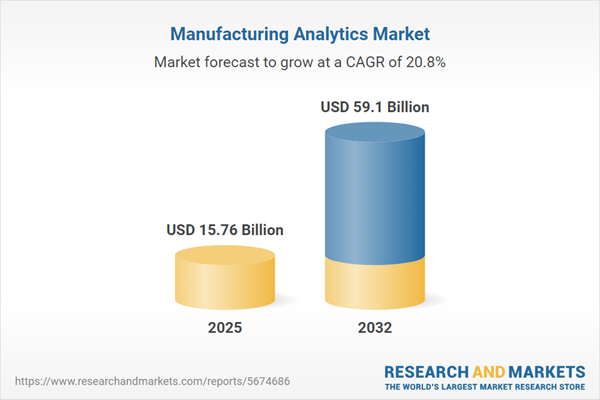Speak directly to the analyst to clarify any post sales queries you may have.
Manufacturing analytics is transforming the global manufacturing sector, driving smarter operations, improved quality, and increased resilience for manufacturers navigating evolving technology landscapes and shifting economic conditions.
Market Snapshot: Manufacturing Analytics Market Growth and Outlook
The Manufacturing Analytics Market grew from USD 13.04 billion in 2024 to USD 15.76 billion in 2025 and is projected to maintain a CAGR of 20.79%, reaching USD 59.10 billion by 2032.
Scope & Segmentation: Diverse Applications and Regional Coverage
- End Use Industry: Aerospace & Defense, Automotive (Commercial Vehicle, Passenger Vehicle), Electronics (Consumer Electronics, Industrial Electronics, Semiconductor), Food & Beverages, Oil & Gas.
- Applications: Predictive Maintenance, Production Planning & Scheduling, Quality Management, Supply Chain Optimization.
- Analytics Types: Descriptive Analytics, Predictive Analytics, Prescriptive Analytics.
- Organization Size: Large Enterprises, Small & Medium Enterprises.
- Regional Scope: Americas (North America: United States, Canada, Mexico; Latin America: Brazil, Argentina, Chile, Colombia, Peru), Europe, Middle East & Africa (Europe: United Kingdom, Germany, France, Russia, Italy, Spain, Netherlands, Sweden, Poland, Switzerland; Middle East: United Arab Emirates, Saudi Arabia, Qatar, Turkey, Israel; Africa: South Africa, Nigeria, Egypt, Kenya), Asia-Pacific (China, India, Japan, Australia, South Korea, Indonesia, Thailand, Malaysia, Singapore, Taiwan).
- Leading Companies Profiled: Siemens Aktiengesellschaft, General Electric Company, PTC Inc., International Business Machines Corporation, SAP SE, Microsoft Corporation, Schneider Electric SE, Rockwell Automation Inc., Oracle Corporation, Aspen Technology Inc.
Key Takeaways: Strategic Insights for Manufacturing Analytics
- Adoption of real-time analytics platforms enables manufacturers to optimize asset utilization, minimize downtime, and respond swiftly to changing production demands.
- Intelligent manufacturing analytics facilitate the shift from reactive maintenance to predictive and prescriptive strategies, enhancing operational reliability and workplace safety.
- Integration of artificial intelligence, machine learning, and edge computing reduces silos between production, design, and supply chain, creating unified data ecosystems.
- Industry-specific requirements drive analytics solution customization, with sectors such as aerospace & defense prioritizing compliance, while automotive emphasizes predictive systems for uptime.
- Regional differences influence market adoption: North America leads in technology deployment, Europe invests heavily in Industry 4.0, and Asia-Pacific is expanding rapid smart factory initiatives.
Tariff Impact: Navigating Shifting Trade and Sourcing Dynamics
With new United States tariffs set for 2025, manufacturers face increased production costs, especially for key inputs like steel, aluminum, and semiconductors. Procurement teams are adjusting strategies, exploring alternative suppliers, and renegotiating contracts to address these challenges. As a result, nearshoring and reshoring efforts are becoming more prominent, presenting both risks and benefits. Manufacturing analytics platforms are essential tools for modeling these scenarios, assessing cost impacts, and informing inventory management.
Methodology & Data Sources
This report leverages a mixed-method approach, including in-depth interviews with senior executives and engineers, alongside thorough secondary research encompassing filings, industry literature, and technical documentation. Quantitative findings are validated through triangulation with authoritative datasets, with expert advisory reviews ensuring analytical rigor.
Why This Report Matters: Decision-Driven Value for Leaders
- Provides frameworks to evaluate technology investments that align with operational and strategic business goals.
- Offers actionable insights on segmentation, regional trends, and risk mitigation, empowering leaders to drive analytics-led transformation.
- Enables effective scenario planning to navigate external pressures, such as tariffs and evolving global supply chains.
Conclusion
Manufacturing analytics empowers organizations to adapt in a complex landscape, supporting agile decision making and competitive positioning. Leaders equipped with these insights will be better prepared to navigate technological disruptions and industry shifts for sustainable enterprise growth.
Additional Product Information:
- Purchase of this report includes 1 year online access with quarterly updates.
- This report can be updated on request. Please contact our Customer Experience team using the Ask a Question widget on our website.
Table of Contents
3. Executive Summary
4. Market Overview
7. Cumulative Impact of Artificial Intelligence 2025
List of Figures
Companies Mentioned
The companies profiled in this Manufacturing Analytics market report include:- Siemens Aktiengesellschaft
- General Electric Company
- PTC Inc.
- International Business Machines Corporation
- SAP SE
- Microsoft Corporation
- Schneider Electric SE
- Rockwell Automation, Inc.
- Oracle Corporation
- Aspen Technology, Inc.
Table Information
| Report Attribute | Details |
|---|---|
| No. of Pages | 181 |
| Published | October 2025 |
| Forecast Period | 2025 - 2032 |
| Estimated Market Value ( USD | $ 15.76 Billion |
| Forecasted Market Value ( USD | $ 59.1 Billion |
| Compound Annual Growth Rate | 20.7% |
| Regions Covered | Global |
| No. of Companies Mentioned | 11 |









